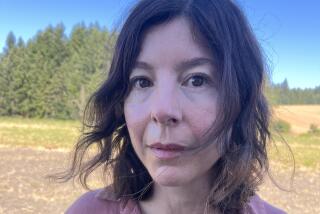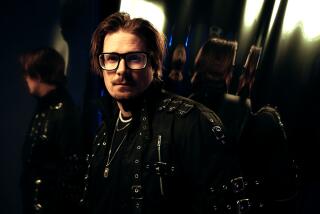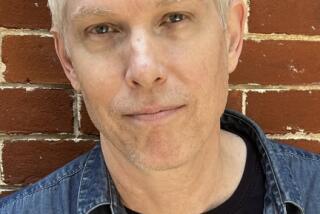Teenage Wasteland : BROKE HEART BLUES: A Novel; By Joyce Carol Oates; Dutton; 384 pp., $24.95
From the playing fields of Eton to the parking lots of Columbine, there is little doubt that high school is the battlefield of our greatest victories and most crushing defeats. Graduation, much like Armistice, leaves us--in the words of British poet Frances Cornford’s eulogy for Rupert Brooke--”magnificently unprepared / For the long littleness of life.”
So it is for the Circle, the group of a dozen-odd students of Willowsville High School in suburban Buffalo, N.Y., who raise their voices in chorus to sing Joyce Carol Oates’ latest novel, “Broke Heart Blues.” Children of privilege, they have grown up together in the classrooms and country clubs of Willowsville, all of them rebels without a cause, rebels who “didn’t want to jeopardize our allowances or cause our parents worry, especially our moms.”
Yet the song they sing, as they look back at their finest hours from the redwood decks of later years, is not about one of their own. Reunion after reunion, the theme they return to is the Ballad of John Reddy Heart, a boy who came out of the West in the summer of sixth grade to forever change their lives.
John Reddy Heart drove into Willowsville on a hot July afternoon, “muggy like the inside of, say, a Coke bottle,” at the wheel of a Day-Glo pink-orange Cadillac dragging a U-Haul trailer with Nevada plates. In the back seat sat his younger brother and sister, his aged grandfather, Aaron Leander Heart (later renowned as the prophet-architect of that masterpiece of folk art, the Glass Ark) and, in the front, dressed all in white, her eyes covered by a lace veil, John Reddy’s mother, the voluptuous Dahlia Magdalena Heart. The Heart family had reached the end of a pilgrimage that began in Las Vegas when Col. Esdras Edgihoffer, a prominent citizen of Willowsville, succumbed to a massive coronary shortly after handing over the keys to his Willowsville mansion to Dahlia. No matter that John Reddy is only 11 and has to sit on three telephone books to see over the steering wheel of the Cadillac. In Dahlia’s eyes, he is the man of the family. In the eyes of Willowsville, his legend has begun.
Strong, silent, polite, John Reddy Heart grows up to become the star forward of the WHS basketball team. “John Reddy, we’re ready,” cry Veronica and Mary Louise and Bibi and the rest of the cheerleaders, who, although they have boyfriends they’ve been dating for years, love this mysterious boy from a family their parents shun--although certain of their fathers have been seen escorting the white-clad Dahlia Heart to “business lunches” in the greater Buffalo metropolitan area. It is no surprise--rather, an immense thrill--when, one cold winter’s night, one of these fathers is shot dead in Dahlia’s bedroom and the murder weapon is recovered, spattered with John Reddy’s fingerprints. “At sixteen,” one of his classmates remembers, “when the rest of us were popping zits in the bathroom and trying to scrounge more allowance out of our dads, John Reddy was a man.”
After a 72-hour manhunt, John Reddy is arrested on an ice field on Mt. Nazarene in the Adirondacks. On trial, John Reddy provokes a frenzy among male and female classmates alike. Acquitted of murder, John Reddy becomes the object of general rejoicing, until he is sentenced to a year’s detention in a youth camp for related offenses. Upon his release, John Reddy’s silent presence back at Willowsville High School blooms into a cult of gossip that flowers upon his mysterious disappearance after graduation.
*
But it is in the years that follow, as the members of the Circle go off to college, find careers and marriages, beget children, divorce, die and return, in one form or another, every five years to a Willowsville reunion, that the legend of John Reddy Heart blossoms to biblical proportions in the gospels of his remaining apostles.
Oates sets “Broke Heart Blues” in the American 1960s--well, sort of. At times, the ghosts of ‘50s icons James Dean, Natalie Wood and Sal Mineo sprawl on the manicured lawns of Willowsville. Other times, signposts to other decades are planted in the narrative--Dahlia Heart seeing “poor Elvis perform in the last year of his life” in Vegas, references to Alzheimer’s disease--that place John Reddy’s high school years firmly in the ‘80s. The few details that would help locate the novel squarely in history--the assassination of JFK, the Vietnam War--are lobbed like red herrings into the sea of stories. The effect is wonderfully, anachronistically disorienting. There is something distant and mythically vague about the place, the accent, the language of these teenagers, as if Steven Millhauser were the head writer of “Peyton Place” or George Lucas had entrusted the screenplay of “American Graffiti” to Vladimir Nabokov. Oates struts and frets like Marlon Brando in “The Wild One,” daring all comers to cross her vision of a late-century Main Street that we’ve seen only in our dreams--street signs, store names, and calendar dates blocked by sleep.
Oates, in fact, is at her best when she confuses and obfuscates and rebels against realism. It is only when her chorines take center stage and act out their standard little ironies--the suspected suicide victim who reappears to dance with his true love, the class clown who, at age 50, finally gets to neck with his fantasy girlfriend only to discover she’s had a double mastectomy--that the novel begins to feel long and little. Most confusing of all is the author’s decision to include a middle section in the three-part “Broke Heart Blues,” sandwiched between the New Testament of the high school years and the Revelations at the 30th reunion. Discarding the virtuosic voice of the Circle, Oates uses this intermission to give a pedestrian account of the historical John Reddy. We learn the early history of John Reddy, the Las Vegas years; we find out what became of him after he graduated, how he became (nudge, nudge) a carpenter known as Mr. Fix-It. We discover what really happened that fateful night in Dahlia Heart’s bedroom. We develop what we never asked for--the kind of psychological profile of John Reddy that semi-educated acting students pencil into the margins of play scripts.
History, after all, is always second best to myth. Homer always upstages Heinrich Schliemann and, at last look, the Bible was still outselling “The Search for the Historical Jesus.” Clearly Dr. Oates wants to do her podiatric best to show us the clay around the stigmata. But one wishes that she had trusted not just her characters but also the rest of us arrested teenagers to recognize, in our hearts, the adulterous liaison of truth and lie. “Doctor,” we all might cry with one of her lost souls, “I realize this is an adolescent fantasy. I realize my marriages have been damaged by it. But if I outgrow John Reddy Heart, what will I have left?”
More to Read
Sign up for our Book Club newsletter
Get the latest news, events and more from the Los Angeles Times Book Club, and help us get L.A. reading and talking.
You may occasionally receive promotional content from the Los Angeles Times.







